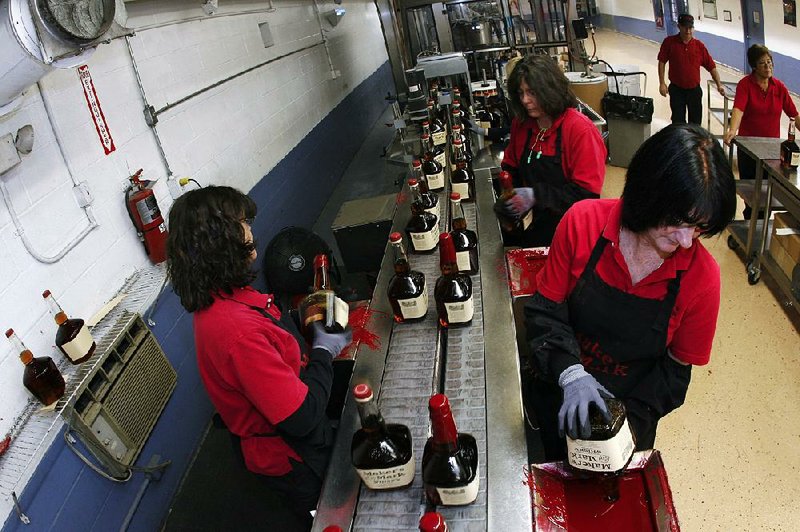LITTLE ROCK — Talk about diluting the brand.
Thousands of bourbon drinkers told Maker’s Mark that it bottled a big mistake when it reduced the alcohol content - from 90 proof to 84 proof - in its signature whiskey.
Within a week, a spirited outpouring of protests elicited a promise to return the alcohol content to 90 proof, or 45 percent alcohol by volume.
Consumers spoke. The company listened.
Maker’s Mark is just the most recent company to misjudge its customers or its product and then backpedal to protect its brand.
It wasn’t easy. A week ago, Bill Samuels Jr., the chairman emeritus of Maker’s Mark, called the interlude the “worst four or five days in my life.”
At least Samuels’ agony was short-lived. When companies mess with their brands, consumer rebellion sometimes lasts far longer. And one thing’s for sure in the Internet age: Social media let reaction pop up faster, spread further and potentially last longer.
Netflix, for example, stumbled for months - in the court of public opinion and on Wall Street - when subscribers reacted angrily in 2011 to new pricing and distribution plans for its video streaming and DVD rental service. The company lost 800,000 customers and $9 billion in market value in less than four months after it instituted a 60 percent price increase.
“I messed up,” Reed Hastings, Netflix’s chief executive, wrote to customers. “I owe you an explanation.”
The explanation, which included splitting the company into two parts, one for mailed DVDs, the other for online streaming, didn’t sit well with customers. The company was reunited, but many customers remained upset.
One result: DVD rentals jumped at the kiosks run by the Netflix rival Redbox.
Other brand battles stun companies that were trying to debut a new look. In 2010, the clothing chain Gap rolled out a new logo to replace its 20-yearold visual - and customers came apart at the seams.
“Now, given the passionate outpouring from customers that followed, we’ve decided to engage in the dialogue, take their feedback on board and work together as we move ahead and evolve to the next phase of Gap,” Marka Hansen, president of Gap North America, wrote in a blog post within a week of the rollout.
The new look was scuttled, and the old “Gap in a box” visual was reclaimed.
And, in what perhaps was the archetypal modern branding misstep, consumers skewered Coca-Cola in 1985 after it introduced a new recipe. Within three months, the company revived the old formula as Coca-Cola Classic. “New Coke” eventually disappeared in the United States, except as a worst-case marketing study.
Cynics suggest that such moves could be clever marketing ploys to keep product names in the news and foremost in customers’ minds.
Tom Fischer, who writes BourbonBlog.com, wondered, “Could (Maker’s Mark) have just tested all of us to see what we would do? I don’t think they did that, but it’s possible.”
Samuels and his son Rob, Maker’s Mark chief operating officer, quickly debunked any devious marketing ploy.
“While we thought we were doing what’s right, this is your brand - and you told us in large numbers to change our decision,” they wrote in a letter to the public. “You spoke. We listened. And we’re sincerely sorry we let you down.”
The Washington Post reported that Maker’s Mark salesrose 14 percent in 2011 and 15 percent in 2012. Its sales, the newspaper reported, are part of a broader trend: Some 16 million cases of Kentucky and Tennessee whiskey were shipped in 2011, according to the Distilled Spirits Council, up from 14.7 million cases in 2006; the revenue earned on that whiskey soared more than 25 percent in that span.
The criticisms and response, mostly distributed through social media and e-mail, followed the company’s announcement that demand for Maker’s Mark was exceeding its supply. Instead of raising prices, a standard strategy to balance supply and demand, Maker’s Mark decided to “stretch” its bourbon supply by 6 percent. It did that by reducing the alcohol content from 45 percent by volume to 42 percent.
And, adding to the dispute were comments from discerning imbibers who tried the 84-proof product and challenged Maker’s Mark’s contention that the taste wasn’t affected.
Pasquale Trozzolo, chief executive at Trozzolo Communications Group in Kansas City, Mo., who also teaches a college-level course on branding, said he doubted that Maker’s Mark strategized to put its bourbon in the news this way.
“But it certainly ignited brand loyalty,” Trozzolo said. “People said, ‘We love you. Don’t do that.’ And even with the outrage, the move didn’t endanger anybody. And the company handled it well.”
Kenny Cohrs, the bar manager at Cafe Trio in Kansas City, said the Maker’s Mark liquid dilution surprised a lot of bourbon drinkers and fellow bar managers.
“Lots of folks were wondering why they would change. It was a good brand,” Cohrs said. “What’s fantastic now is that a company that big would so quickly take into consideration what its customers were saying.”
In a wide-ranging report on consumer trends, headlined “This Time It’s Personal,” the accounting firm Ernst & Young emphasized the power that the Internet has put in customer hands:
“Authority has moved from the detached to the personal; from national or international media channels to sectional or community blogs; from the objective expert to the known friend, relative or trusted blogger.”
In other words, today’s manufacturers or marketerscan’t necessarily tell consumers what their brand is.
“Buttons can be pressed to generate consumer response,” Trozzolo said. “But the power rests with the consumer to define the brand.”
Business, Pages 67 on 02/24/2013

